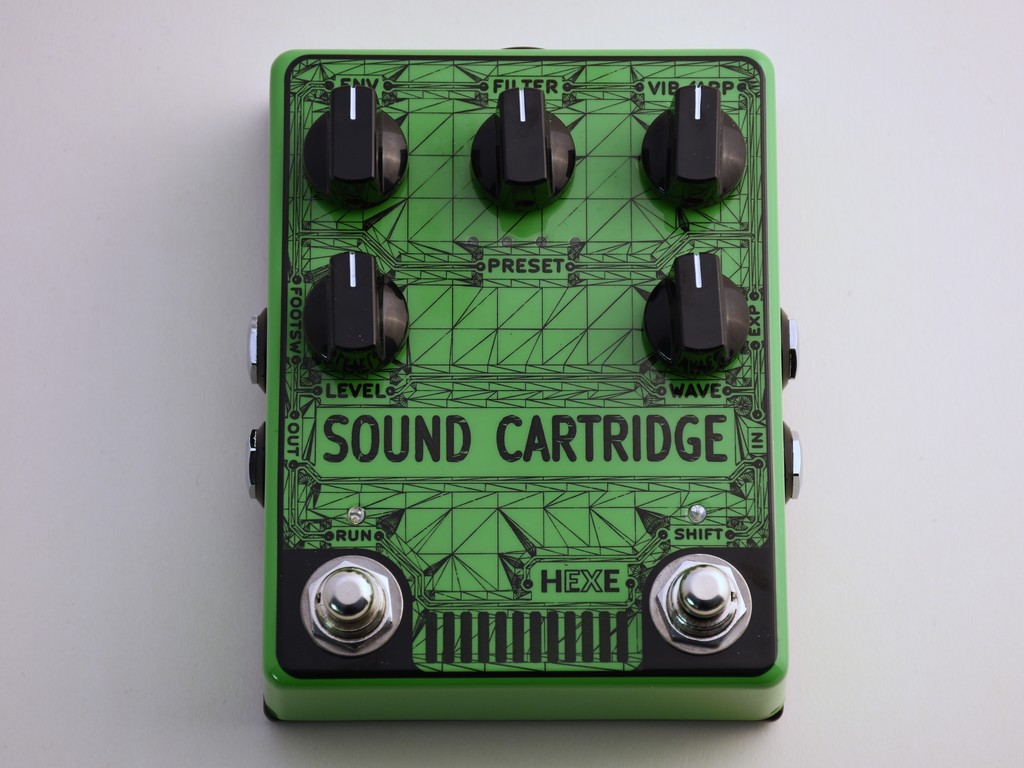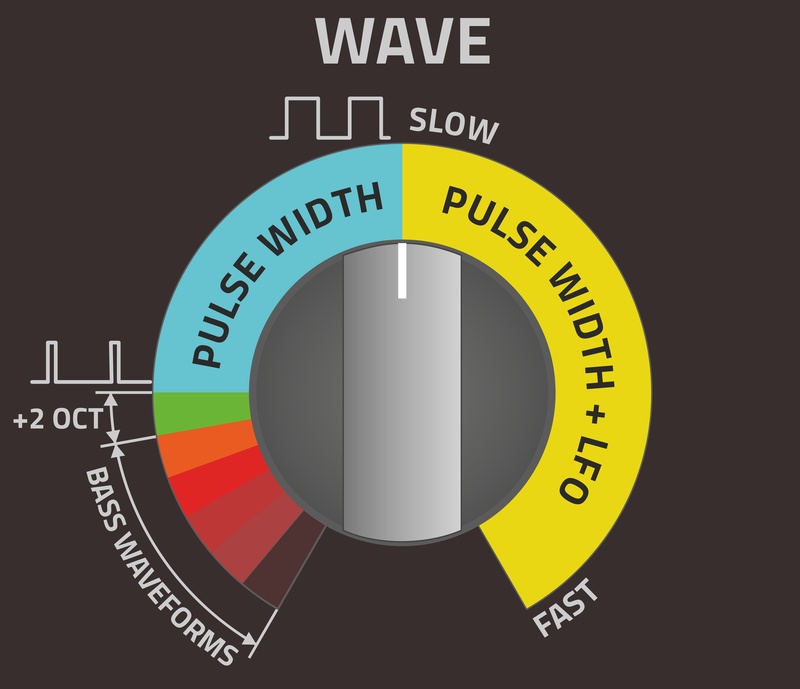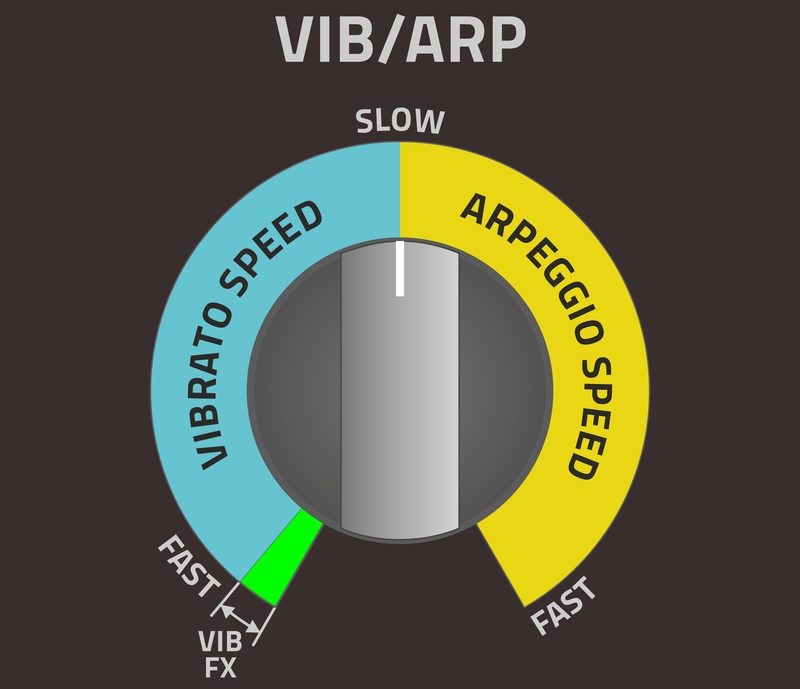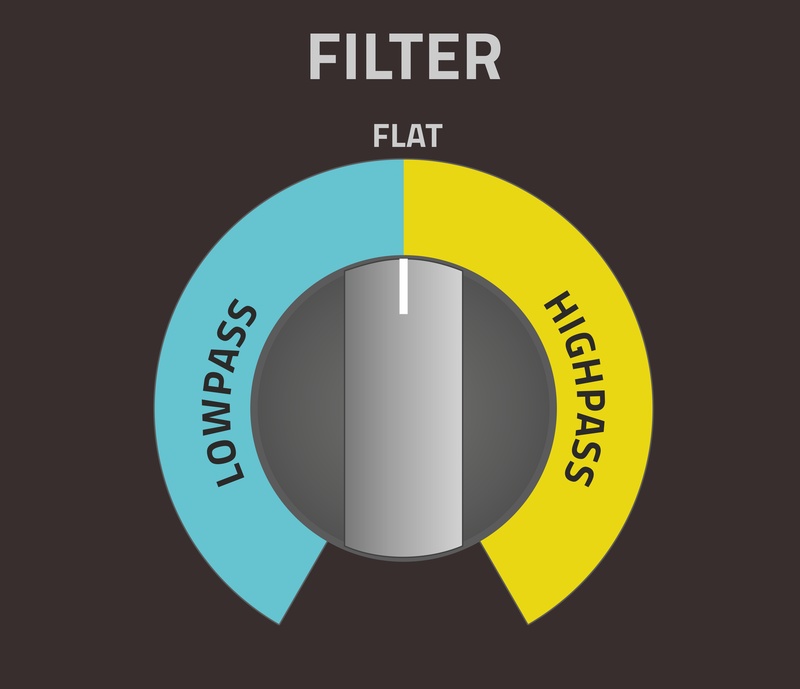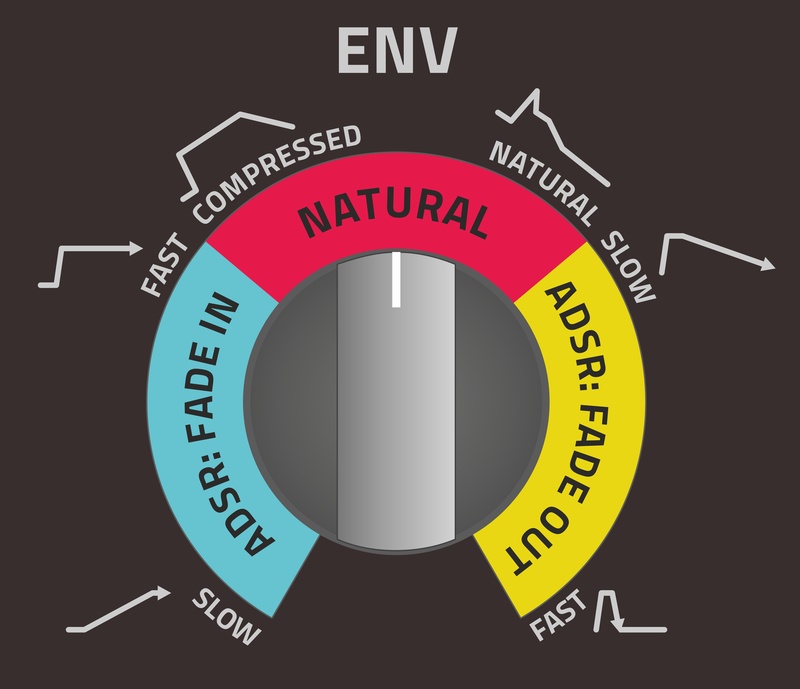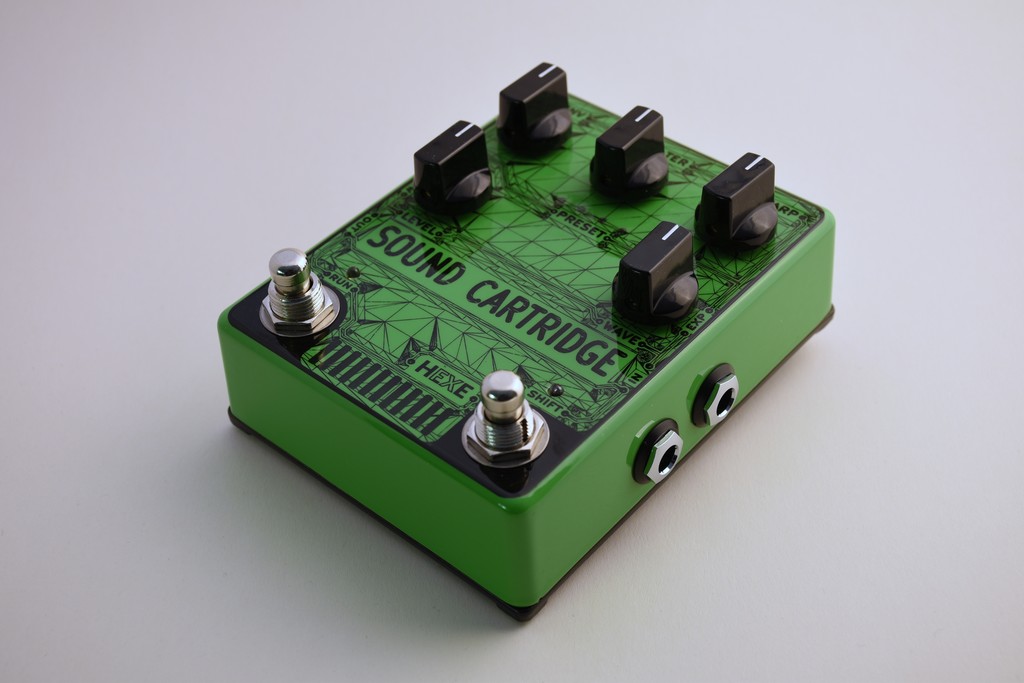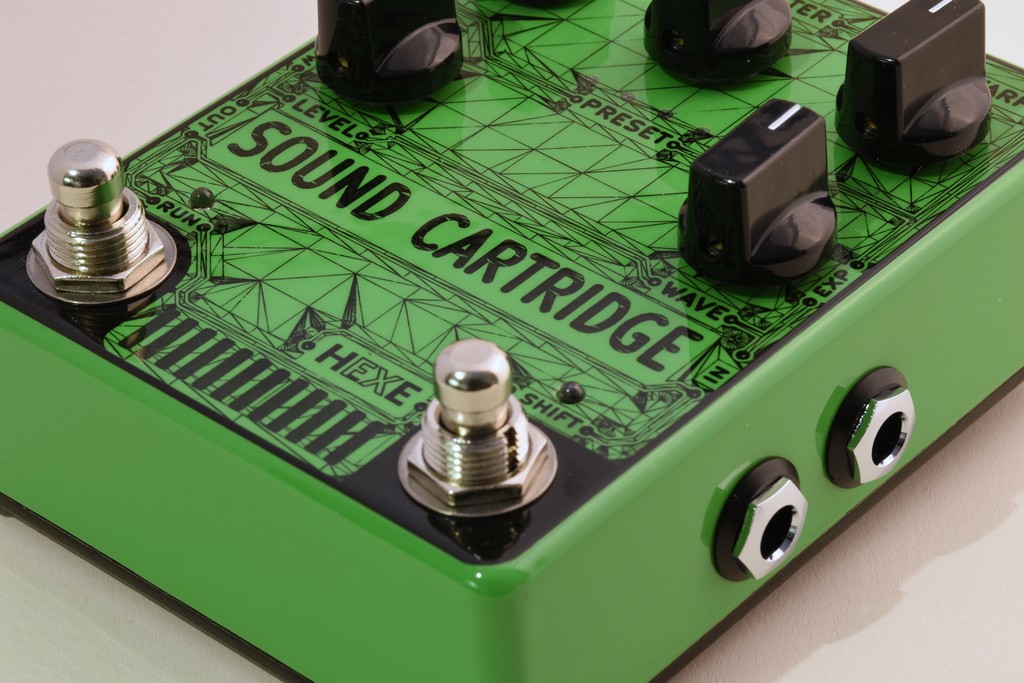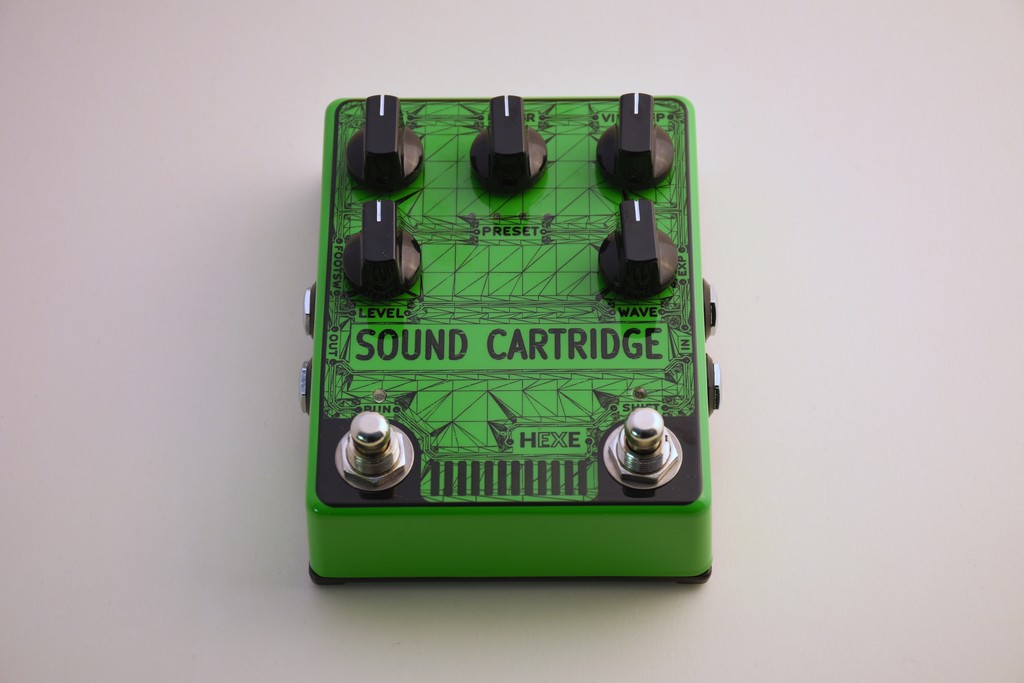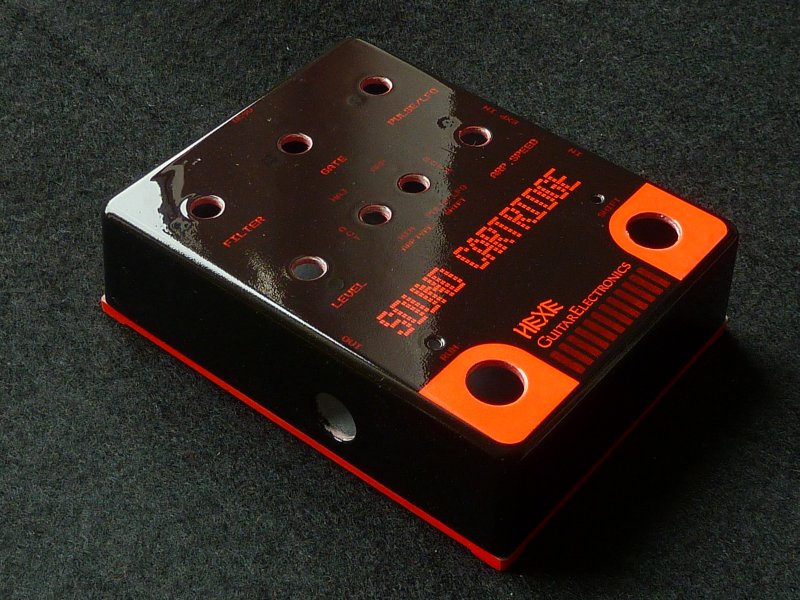Guitar chip tune station.
This pedal will take your guitar back to 80's pioneer home microcomputer era. Focused mainly on recreating minimalist sounds produced by the POKEY chip. A mixture of synthy fuzz, vibrato, arpeggiator and filters combined with easy access to any sounds using an expression pedal.
Controls:
Contrary to many classic controls, the knobs on Sound Cartridge perform a few different functions allowing a continuous parameter change or in some cases also an option to switch something on or off, choose a waveform etc. This way all the available sounds are accessible via knob position, thus all the sounds can be accessed using an expression pedal. All that in 4 available presets.
Let's take a look what each knob does.
WAVE | VIB/ARP | FILTER | ENV | LEVEL | FOOTSWITCHES | EXPRESSION PEDAL | EXT FOOTSWITCH
WAVE:
As the name implies, this knob controls the waveform and has 3 ranges responsible for 3 different types of sounds:
- BASS range: in this range the knob sets one of the 6 available waveforms which mimic that very characteristic POKEY chip bass sound. Starting from a more clean bass, the following settings have more upper octave added, ending up on a clean +2 octave sound. Not really a bass, but it's instability makes it an excellent setting for creating any type of blips and digital noises. A very important feature in a chiptune music device.
- PULSE WIDTH range: static, non modulated pulse waveform, from narrow peak to harmonic reach square wave.
- PULSE WIDTH LFO range: modulated pulse width mode, knob controls the LFO frequency.
VIB/ARP:
Vibrato / arpeggio control. Both effects are switched off in the middle position.
- Turning the knob anticlockwise turns on the Vibrato, starting from very slow modulation up to very fast 15Hz setting. The max position is used to switch on a special FX, a fast vibrato combined with slow pitch down.
- Turning the knob clockwise turns on the Arpeggiator with the knob controlling it's speed. The arpeggio consists of 3 steps, +1 octave, natural pitch and -1 octave. At very high speeds arpeggio switches to 2 step mode using a +1 oct and the natural pitch, reason for that being a much cleaner and musically useful sound.
FILTER:
- Middle position results in flat response (filter bypassed).
- Turning the knob back to 0 applies the lowpass filter with sound getting darker while approaching the minimum position.
- Range from 50% to 100% results in high pass filter, with decreasing the bass content while reaching the maximum position.
ENV:
Envelope control, split into 3 ranges:
- Triggered FADE-IN, slow to fast parameter range.
- Original envelope, compressed (as ie in a fuzz) to natural with more accented attack.
- Triggered FADE-OUT, slow to fast parameter range.
LEVEL:
The most boring, yet necessary knob, it controls the output volume.
FOOTSWITCHES:
RUN:
- Short press: effect on/off (true bypass)
- Hold down: change preset
SHIFT:
- Short press: freeeze sound
- Hold down: freeze off
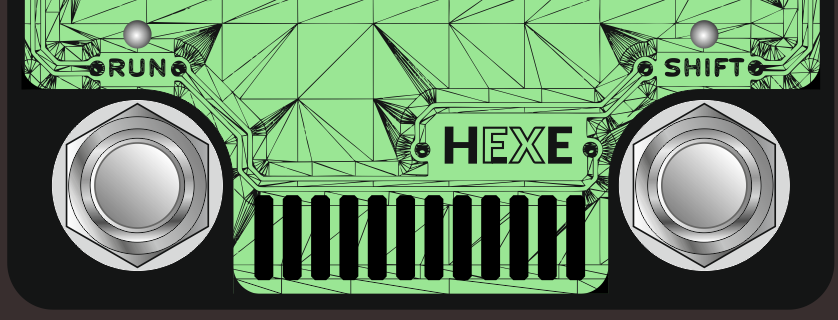
EXPRESSION PEDAL:
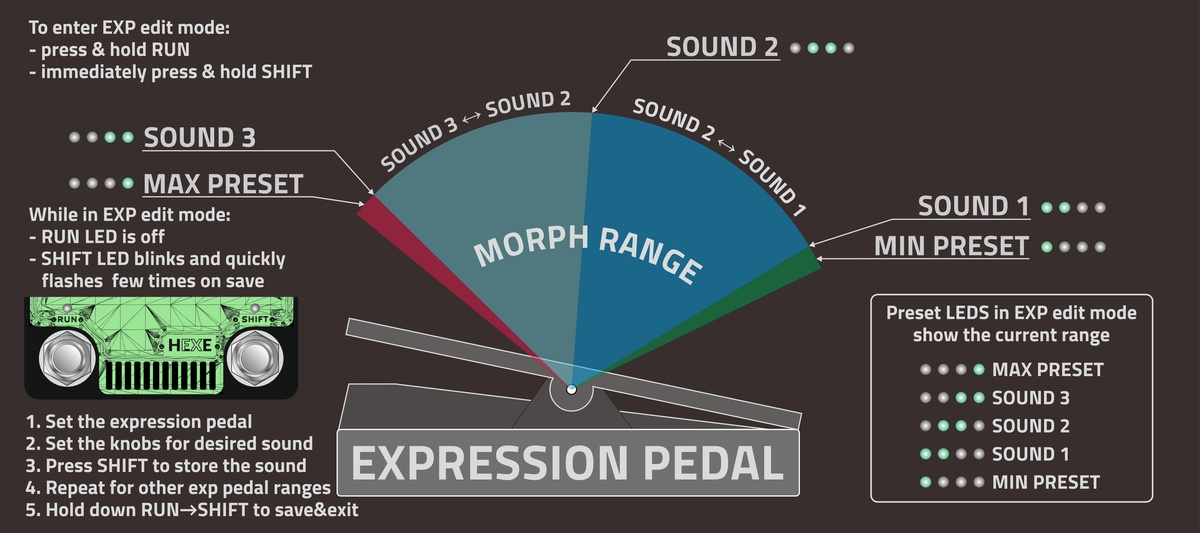
Expression pedal control is one of the most useful features in the Sound Cartridge pedal. It allows to morph the sound between 3 snapshots of all knobs positions marked on the diagram above as Sound 1, Sound 2 and Sound 3. In addition, the heel and toe expression pedal positions are used to switch on two additional sound presets. This gives a really flexible, easy and instant hands free access to any sound the pedal can produce.
Ontop of being able to switch two separate sounds, morph between three of them, all expression pedal settings can be stored in 4 available presets.
EXTERNAL FOOTSWITCH:
A dual momentary type footswitch can be used to add more arpeggiator related features:
Footswitch 1 (Tip-Sleeve):
- Short press: activate the arpeggiator and tap a new tempo. One step per tap.
- Hold down: switch the arpeggiator off.
Footswitch 2 (Ring-Sleeve):
- Hold down (momentary action): starts an arpeggiator based pitch down effect.
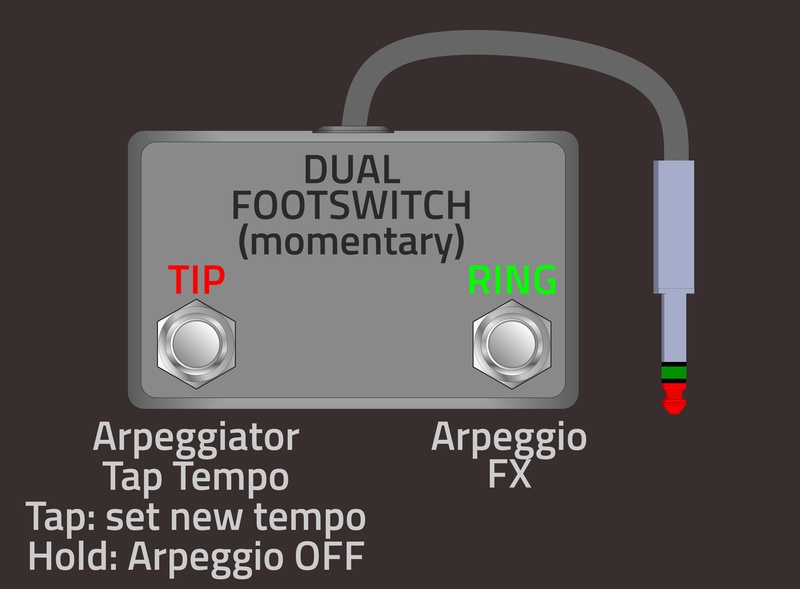
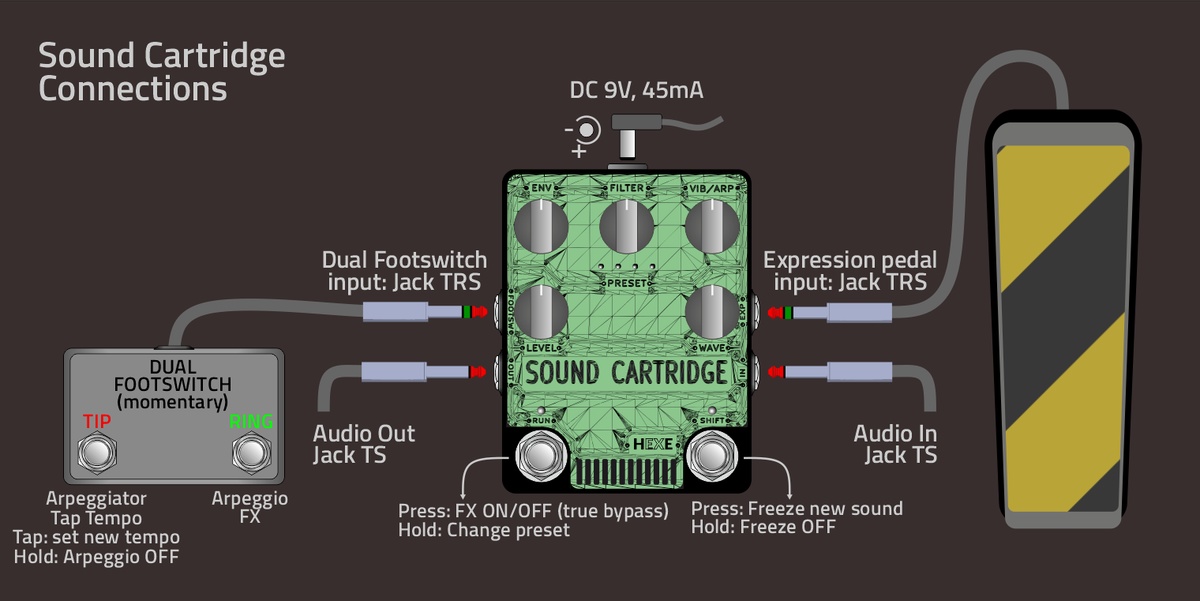
What is Sound Cartridge?
Definitely not an easy device to classify. Although most of the features happen in the digital domain the operation resembles a mixture of a synthy fuzz, analog octaver, pitch shifter (vibrato/arpeggio), envelope controller with a smart sound morphing capabilities for easy hands free access to any sound the pedal can produce. It is a pedal that is designed to be an instrument.
Sound Cartridge is optimized to track guitar range of frequencies. It will work with bass, but the waveform and frequency tracking will not be as stable as when using a guitar.
Similar to analog octavers the best results are achieved when using the neck pickup. In many cases a soft palm muting really helps to control the waveform shape and amplitude or triggering (when using an triggered envelope generator).
Sound Cartridge Quickstart - a handy guide as PDF file showing all the main features of the pedal.
Freeze function:
- Pressing the SHIFT footswitch while playing will freeze the current sound and allow to play over it. Any parameter changes will not affect the frozen sound.
- Pressing the SHIFT again will recapture a new sound.
- Pressing and holding down the SHIFT footswitch will switch the Freeze off.
Expression pedal use:

Presets:
There are 4 available preset slots for expression pedal settings, multiplying further the number of programmable sounds.
Changing the preset:
- Hold down the RUN footswitch, pedal will enter a preset-change mode indicated by a blinking preset led.
- A steady lit led shows the current preset, keep pressing the RUN footswitch to browse for a new preset, indicated by a blinking led.
- Once a new preset is chosen, press and hold RUN to activate it.
Setting the input gain:
It might be necessary to adjust the input gain of the pedal to match the output level of the instrument. An example would be a guitar with a very low output pickups resulting in cutting the note off too early. Adding more gain will improve the tracking and envelope triggering. On the other hand, too hot pickups will result in signal clipping, which impacts the envelope follower and shape of the attack part.
To change the input gain do the following steps:
- Power off the pedal.
- Hold down the RUN footswitch and apply the power.
- Pedal will boot up in the Input-Gain setup mode, the leds will blink in RUN→SHIFT→RUN→SHIFT order.
- Preset LEDs will show the current setting. The default one is 3 (3 leds are on).
- Use the SHIFT footswtich to increase the input gain or press RUN to decrease it.
- Once done, press and hold down RUN, then press and hold down SHIFT. Pedal will store the new setting and resume normal operation.
Factory reset:
Factory reset will restore the listed parameters to default ones:
- Expression pedal range settings for all 4 presets.
- Input gain setting.
Performing the factory reset requires an external dual footswitch to be plugged in:
- Power off the pedal.
- Press and hold down both switches (Arpeggio Tap tempo + Arpeggio FX) on the external footswitch.
- Apply the power to the pedal.
- Factory reset will be performed, once done the Preset leds will bounce left to right and back a few times, indicating success.
If no external footswitch is available, the operation can be perfomed using a standard mono Jack TS cable (ie. a short patch cable). Shorting the TIP + Ground will act the same way as having both footswitches pressed on.
Plugging such a cable with shorted T+S while the pedal is unpowered, then plugging the 9V jack in will trigger the Factory Reset function. To avoid any accidental Footswitch press events while unplugging the cable, remove the power after the successful Reset, unplug the cable and power the pedal again. It will start with fresh factory settings.
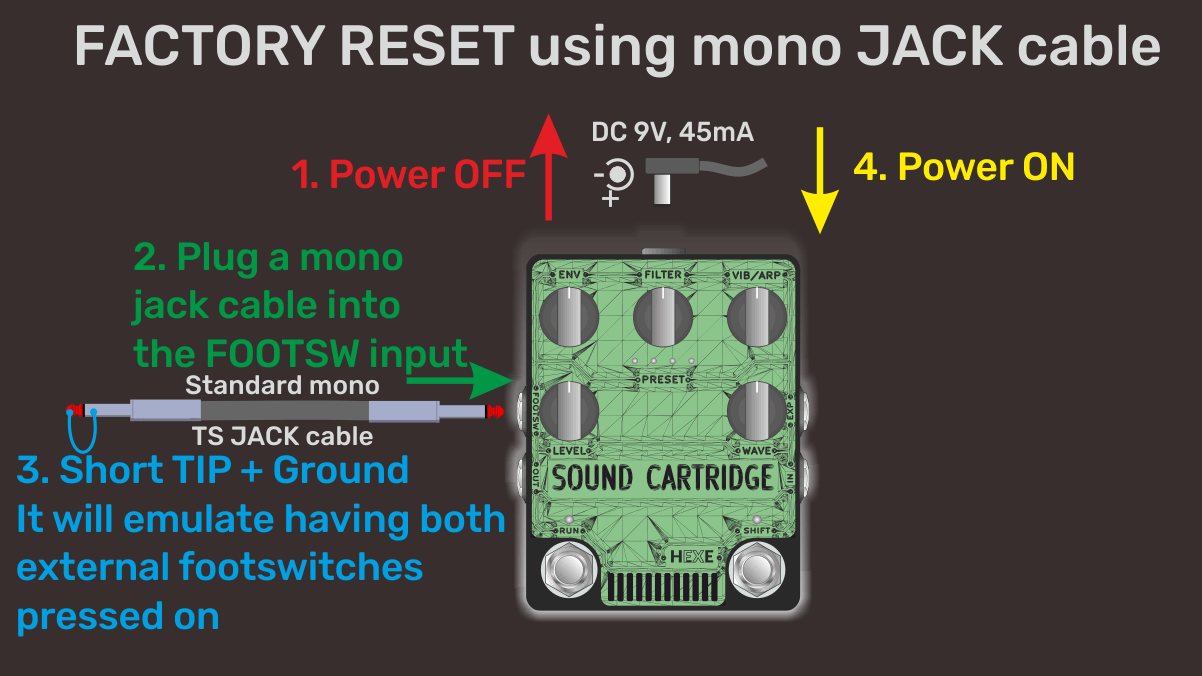
Alarm messages:
Sound Cartridge has a few diagnostic tools built in and shows alarm messages when something is impacting it's correct operation.
- Supply voltage too low - if there is a problem with the power supply and the voltage drops below an acceptable level, pedal will go into bypass and start to blink all Preset LEDs 3 times. Press RUN to reboot the pedal. If it happens again, check the power supply. It means there are voltage drops, most likely due to insufficient output current. Try a 9VDC output/adapter with a higher output current.
- Expression pedal fail - this can happen if the plug polarity of the expression pedal is not compatible with the pedal or, accidentally a mono TS jack is plugged into the EXP IN. In this case all the Preset LEDs will blink 2 times.
Technical info:
- True bypass (relay),
- 1M input impedance,
- below 1k output impedance,
- 9V DC, 45mA power, regulated adapter only. 5.5/2.1mm center negative plug.
Demo videos / Sound Samples:
Story:
The origins of the Sound Cartidge go way back to around 2011 when i started to work on a dedicated chip tune pedal for guitar. A sound, that thanks to my first encounters with 8 bit microcomputers, programming, electronics and making music back in the '80 has a very special meaning to me. For me it wasn't a question if i'm going to design such pedal, but when. And it took some time...
First rough prototype built in 2013 was a rather complex device design wise, yet somehow limited in features. It never got beyond a test circuit on a development board, even though i made a box for it.
I recorded two tracks back then:
Years have passed by, the ideas were coming together tested on experimental builds as the Spacetime Resonator or shown here Sombra Reveb, experience gathered, new options for hardware has become available.
Finally, in the 2019 a critical mass has been reached, the concept for a new generation of pedals solidified and i started to work on the final design with Sound Cartridge being the first of the new line of pedals.
Design goals for the new line of pedals and the Sound Cartridge specifically:
- Highly interactive and easy to use when playing an instrument. This is the reason i decided not to use any toggle/dip switches to access various functions on the pedal. A pedal can have tons of features, but if they are require to flip a switch (not a footswitch) the access is limited. Hence my approach was to make the knobs work partially as switches, too. A maximum or minimum position can be used to turn something on or off. Combined with expression pedal working with snapshots of all settings it gives basically the whole pallete of sounds available under the foot.
- Expression pedal as the main hands free tool to change the settings. Not a one controlled parameter, all of them, morphing between three distinct sounds and an option to switch to two additional ones when the pedal is at heel or toe position. This option blended naturally with the Sound Cartridge concept, using the heel position for a bass sound, the morphing range to sweep between various waveforms and modulations and finally, the toe position to switch the arpeggiator on or off. This is how the first preset is programmed.
- Presets: all sets of 5 different sounds (Min + 3 in morph range + Max) are available in 4 independently configurable preset slots. Presets are available without any expression pedal, too, only limited to 1 sound (MIN exp pedal range).
- External dual footswitch is used to extend the list of interactive features. Normally, the arpeggiator and vibrato share the same knob, hence they can't be used simultaneously. Arp Tap-Tempo footswitch can activate the arpeggio ontop the vibrato. The 2nd footswitch adds an arpeggio based dive bomb sound effect, another crucial sound in the chip tune world :).
- Two features used in the development, which i decided to leave in the final version, cause they might come handy in some situations: a power supply voltage monitor and an expression pedal fail detector. The first one detects power supply problems and 2nd one show an error if the expression pedal has a wrong plug polarity or a mono jack is plugged into the EXP input.
While i mentioned the POKEY chip a few times, the pedal definitely is not an attempt to precisely emulate it or create a way to use the original chip with the guitar. Comparing it with other icon, as the almost fully equipped synth SID chip, the features of the POKEY are more primitive, limited to pulse/square waves resulting in a more raw sounding chip tunes. The limitations often lead to inventing a few nifty tricks to create new interesting sounds. One of them being the very characteritic bass sound found in many tunes created on 8bit Atari. I decided to devote a one section of the "Wave" knob exaclty for these type of sounds. Accidentally creating one, that sounds very close to something we had to listen to quite often back then: loading a game from a cassete, no "turbo mod" version :)
So, POKEY was merely an inspiration for the Sound Cartridge. The other question i asked myself when starting to work on the pedal was the sound generation path. Should i take the synth route, extract the fundamental frequency and generating the rest of the sound independently? Or use something else. The full synth path wasn't appealing, since playing a guitar (or any other non electronic instrument) is so much more than just plucking a string and hearing the frequency. There is a lot of details that shape the final sound, often being a signature of the musician. The articulation, vibrato, bendings, intermodulation beween multiple sounds and all sorts of trick used to decorate the playing style. I didn't wan't to strip the sound out of these things and preserve as much as i can. Hence the decision was made, the Sound Carrdrige will be a hybrid between a synth, fuzz, although fully digital - a kind of analog octaver. It's operation resembles an analog octaver in many ways, it's not polyphonic, the best tracking is achieved when using the neck pickup. A soft palm muting often helps with the attack. It might be unstable at lowest and highest frequency ranges, however, all these things, little imperfections can be creatively used to make new beepy sounds, leave an area to explore. Pedal can still react to playing techniques and from time to time, surprise with a new unexpected outcome.


